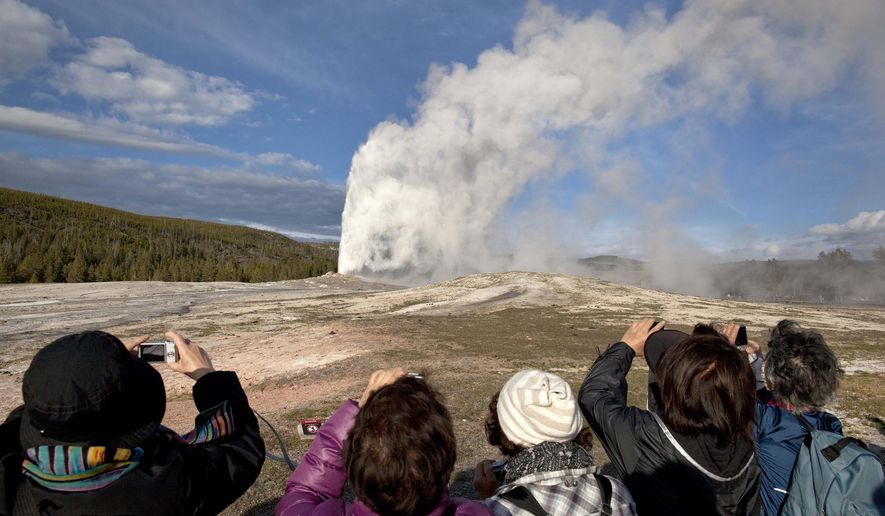JACKSON, Wyo. (AP) - A team of scientists and storytellers will soon be creating futuristic murals to help Yellowstone National Park’s visitors understand what the park will look like late this century.
“The temperature is going to be 2 to 3 degrees Celsius higher than it is now, but that doesn’t mean very much,” University of Wisconsin ecologist Monica Turner told the Jackson Hole News & Guide this summer. “What we’d like to do is show them.”
Her research - and the coming murals - is focused on Yellowstone’s lodgepole pine forests, which are projected to burn more frequently, leaving vistas more open and meadow-filled. Other vegetation will likely shift on the landscape, as will the species that live there.
As they set the scene for the mural of Old Faithful, perhaps the famous geyser ought to be dormant.
A new study headed by U.S. Geological Survey research hydrologist Shaul Hurwitz shows that during the driest of times, Old Faithful goes dormant. If those conditions repeat - and climate scientists forecast a much more arid environment come the middle of this century - it could have major implications for Old Faithful and Yellowstone’s approximately 500 other geysers.
“Eruption intervals might increase,” Hurwitz said. “Or if it’s going to be as arid as it was … it might even stop the geyser.”
The dry period in history when Old Faithful is believed to have gone dormant fell about 650 to 800 years ago, just before the Little Ice Age. Hurwitz and seven others recently detailed the suspected century-plus lull in the pages of the scientific journal Geophysical Research Letters, where they published the article “Yellowstone’s Old Faithful Geyser Shut Down by a Severe Thirteenth Century Drought.” Co-authors included tree ring scientist John King, research ecologists Greg Pederson and Justin Martin, research chemist David Damby, earth and planetary science professor Michael Manga, geologist Jeff Hungerford and hydrologist Sara Peek.
Mineralized wood that former Yellowstone naturalist George Marler found near the Old Faithful eruption mound over 60 years ago is partly what inspired the study. Building off that discovery, Hurwitz and his collaborators secured a research permit and collected 13 additional chunks of wood from near the geyser.
“We used radiocarbon methods to date those pieces,” Hurwitz said, “and they all came within like 100 years of each other.”
The similarities in age were significant because all the wood studied came from trees - likely lodgepole pine - that would have been growing during the 13th or 14th century, which was a period of severe regional drought all over the western United States. Trees, of course, wouldn’t fare too well near Old Faithful’s orifice if the geyser was regularly showering 200-plus-degree water into the air and onto the ground.
“The trees wouldn’t have been growing there if the geyser were erupting,” Hurwitz said. “Today if you go to any Yellowstone geyser there are no proximate trees.”
Although it was a period of dormancy that enabled the trees to grow, it was Old Faithful’s return that preserved the evidence they existed. Silica in the geothermally heated water quickly mineralized the woody remnants, and the hot water inhibited the fungus, bacteria and other organisms that typically break down Yellowstone’s trees in 300 years or less.
While an extended period of extreme drought can stop Old Faithful altogether, less dramatic swings in climate can still influence eruption frequency. Research looking at modern conditions has also found that during wet years Old Faithful erupts slightly more often than it blows during drier times.
Hurwitz said it’s hard to predict with precision what’s ahead for 130-foot-high geyser that predictably goes off every 90 minutes or so.
“We don’t say that it’s going to happen and that Old Faithful is going to go dry,” Hurwitz said. “We say that if the climate models are true, the eruption intervals will become much longer and longer, and if it’s really extreme for a sustained amount of time it might go dry.”
Climate change and the aridity it’s expected to deliver isn’t the only threat to Old Faithful’s famous reliability.
Large earthquakes like the 1959 Hebgen Lake quake and the 1983 Borah Peak quake altered the iconic geyser’s activity, decreasing the frequency of its eruptions, Hurwitz said.




Please read our comment policy before commenting.